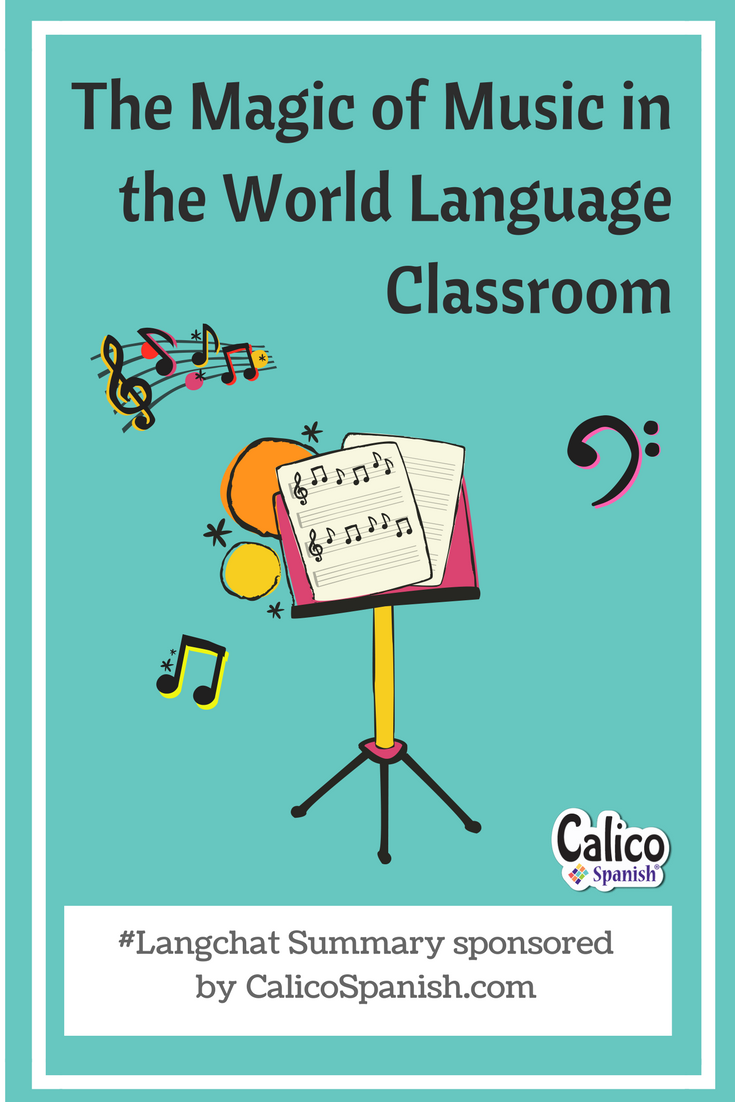The Magic of Music in the World Language Classroom

Last Thursday, #langchat participants considered the benefits of music integration in the world language classroom. Through a discussion on song selection, supporting activities to engage students while increasing proficiency, and exploring cultural practices and perspectives, it can be said that music has a lot to offer in the language learning process.
– Follow the blog on Bloglovin –
Song Selection
#Langchat teachers have discovered a variety of resources for finding great music to share with their students. @Elisabeth13 “checks the top billboard charts in France”, @SrtaPrendergast often chooses songs from “Spotify’s Discover Weekly mix”, and @SraDentlinger said, “Pandora helps [her] find new artists that are like artists [she] already likes!” When deciding on which songs are most useful in the classroom, @MmeBlouwolff said she “looks for a thematic hook to open a unit with comprehensible lyrics and some key vocabulary.” @ADiazMora “[tries] to tie in the songs to the unit theme; sometimes for meaning of song, and sometimes just to jam out.” Repetitive, slow-paced, and culturally embedded songs seem to be strong choices for #langchat teachers. “[I] also love songs that reinforce cultural issues. French rap is FABULOUS for this” (@MlleSulewski). “@SraBurbano said, “Vivir la Vida and Lupita are favorites. I play a lot of Mana and try to tie in the theme.” Finally, @SECottrell shared the “Top 20 @Musicuentos class songs of ‘all’ time.”
– Like Calico Spanish on Facebook –
Activities to Anticipate, Engage, and Reflect on Songs
There are many grammar, pronunciation and comprehension-centered activities that can be integrated into world language lessons through music. @CadenaSensei said, “My typical Level 1 activity is for [students] to listen to (part of) a song [and] mark off adjectives that describe what they think. Then discuss.” @nathanlutz “often [has] props for #earlylang students to use to act out the songs.” “We do ‘slap words’ with song vocab, put lyrics in order, word clouds, and [use] cloze text” (@RhulsHuls). For higher proficiency language levels, many #langchat teachers ask students to make predictions. @CatherineKU72 said, “we tried to imagine [the] video just based on lyrics.” @ ICanSpanish shared, “When it has a good clean video with a story, I like to do a ‘story-go-round’ [where] students take turns finishing the story in circles”. @SrtaPrendergast said, “After focusing on the chorus all week we do a grammar/language activity. ex: brainstorm words that rhyme with something in the [chorus].”
– Follow Calico Spanish on Twitter –
Differentiating Activities Across Levels with the Same Song
There is potential for one song to be used among multiple levels through different activities. @Srta_Sieber said, “lower levels mostly look for grammar structures/vocab; upper levels analyze culture and meaning of a song.” @SraDentlinger suggested, “perhaps tier activities? [Spanish] 1 does [Spanish]–> [English] [definition], [Spanish] 2 matches word to Spanish definition instead.” #Langchat participants often incorporate more challenging activities for higher proficiency language levels. @SenoraJansen said, “upper levels will take 5 new vocab words, and create a skit with 10 minutes to prepare. They’re usually crazy but so funny.” @sr_connolly encouraged teachers to “Grade the task, not the ‘text’. [The] same song can be used for vocab practice [and] cultural/historical context.”
Progressing Towards Proficiency Goals
#Langchat teachers shared their thoughts on how music aids in progressing students toward higher language proficiency goals.
- @SraWienhold said,
Music not only works well for listening practice, but also gives students something to TALK about.
- @SECottrell shared, “IDIOMS. Nothing like it for promoting more natural language sets. In this post you’ll find a long list of Spanish songs with high-frequency idiomatic expressions.”
- @welangley said, “If the song is on a cultural topic we can have real-world discussions.”
- @GrowingFrench mentioned, “Students often dislike listening. Music makes that pill a little easier to swallow.”
– Follow us on Instagram too! –
Exploring Cultural Practices and Perspectives
Music opens a world of culture. “Music is culture! It shows what is important enough to a culture to make it go mainstream. Plus, videos are great for this!” (@rahanagan). @SrtaJustiniano suggested that #langchat teachers “talk about the artists and their cultures or talk about historical significance.” @MlleSulewski shared the unique perspective that love songs can have, “how does ___ culture express love? what problems do people sing about?” In conclusion (@doriecp):
it is easy to discuss products and practices, but music is an accessible way to delve into the perspectives of a culture.
Thank You
Thank you to the lead guest moderator, Allison (@ SraWienhold) and support moderators Elizabeth (@SraDentlinger) and Megan (@MlleSulewski) for leading the chat on music in the world language classroom. Thank you to all the wonderful #langchat participants for sharing your input and suggestions! Have a topic you’d like to discuss? Check out the #langchat wiki and suggest a topic!






No Comments